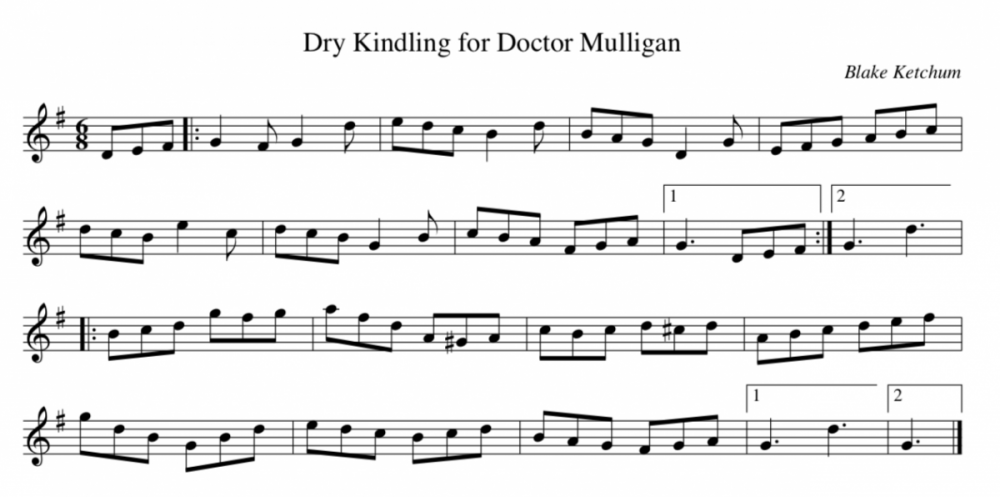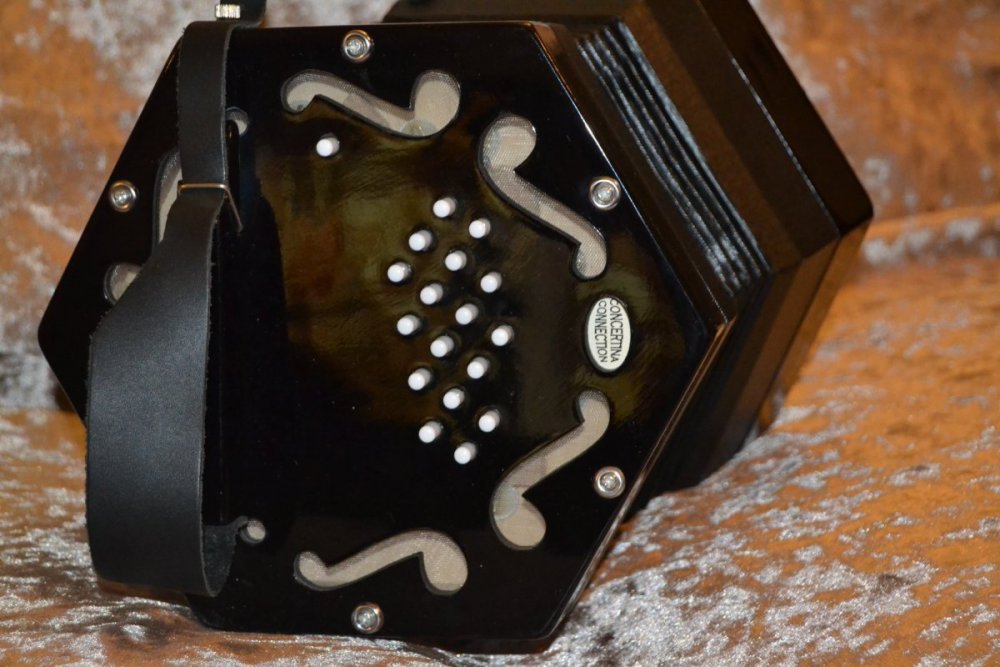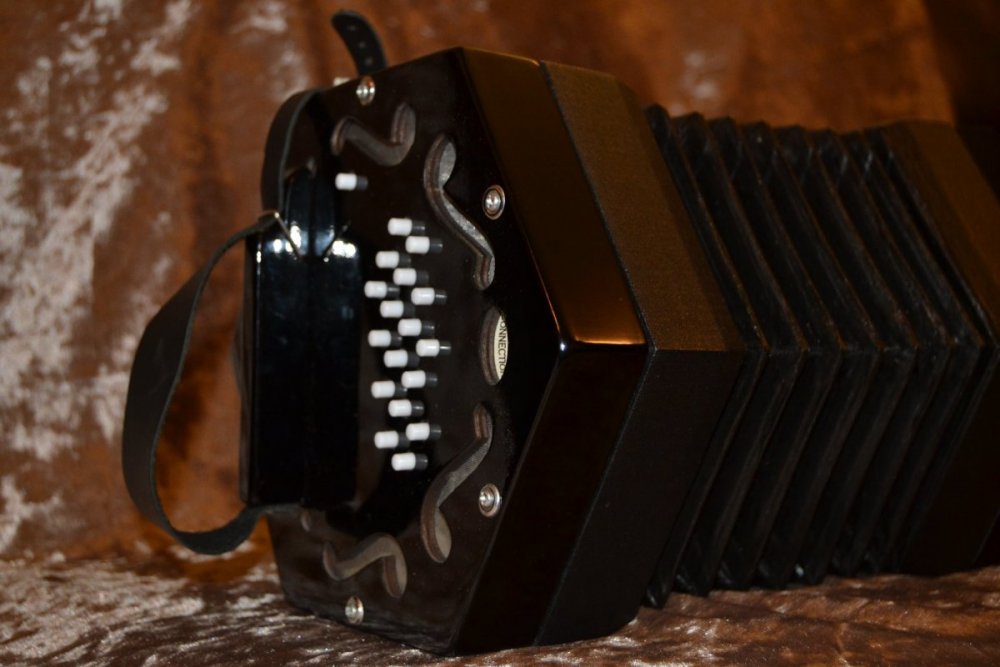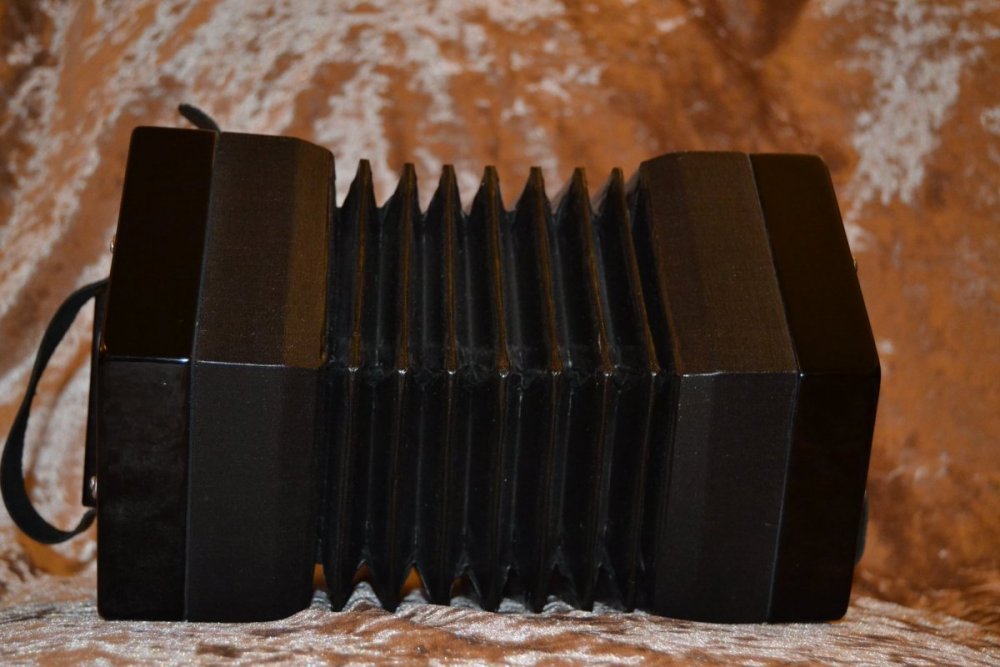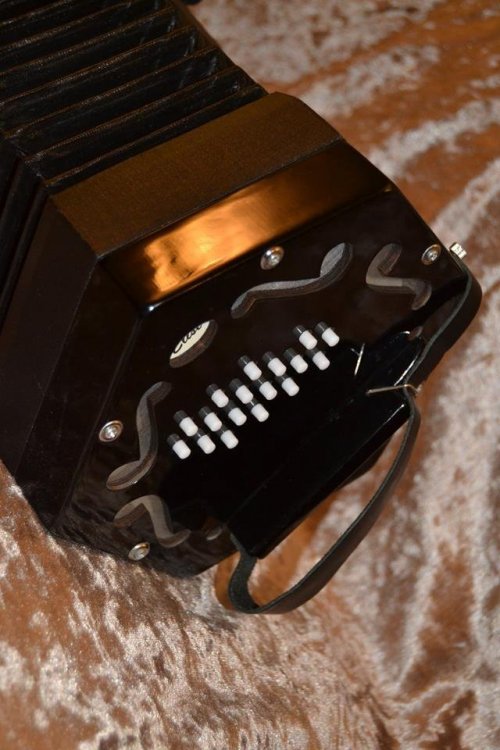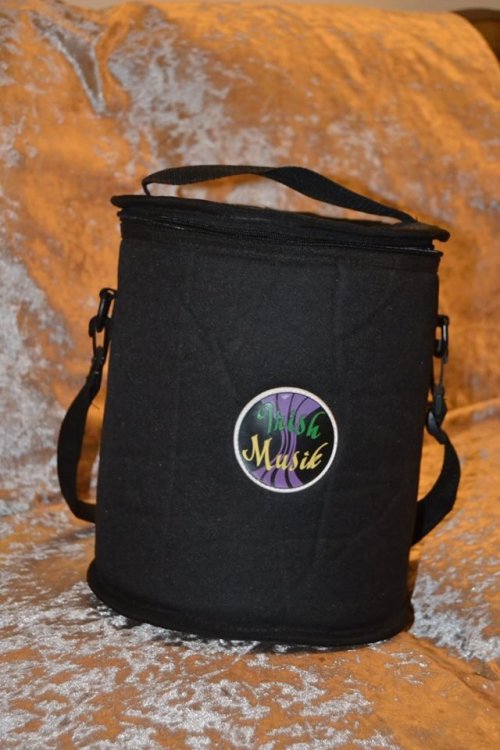
Mikefule
Members-
Posts
1,114 -
Joined
-
Last visited
Everything posted by Mikefule
-
Ah, I see.
-
Strangely, my earlier reply appears to have disappeared, although the OP, Kelteglow has replied to it. In my earlier reply: I asked for clarification: did the OP was asking about modulating or transposing. The answer is "transposing". I suggested moving from G to D by just making the jump. I suggested that, moving from D to G, you could play the D chord on the pull, then add the C note to make a D7 before starting the next round of the tune in G. Howard Mitchell has suggested moving from G to D by putting in an A7 chord. This makes musical sense: A7 modulates to D maj. However, I've tried several ways of doing that and it doesn't make the right sound for me in this particular tune. There are two ways of playing the tune in D on a G/D Anglo. You can play along the rows in the high octave, or you can play "on the pull" in the low octave. In simple terms: The last note of the tune in the key of G is the note G. The first note of the tune in the key of D is the note F# You can choose to move up a big jump up to the higher F#, which is essentially transferring the same fingering to the inside row, or You can move down a small jump to the lower F#, but the fingering will be different. The whole A7 chord is available on the pull (A C# E G) . The notes A E and G are available on the push assuming you have a 30 button. However, to my ear, neither sounds rght when making the transition from G to D in this tune. It is quite a "Morris sound" just to finish the tune in G and then start it in D without breaking time. It is like "crashing the gears" with no modulating chord, but it works. It makes the listener sit up, and it adds spring to the dancers' steps. However, when modulating the other way, from D to G, you have the choice of playing the last note (D) on the push or the pull. If you play it on the pull (using the accidental row for the melody note D) it is easy simply to add a C natural to convert that D chord into a D7 and it flows nicely down into G. There are always many ways to approach any tune on an Anglo. For this particular tune, which is simple and robust, I prefer to hear it played simply and robustly. On a different, more flowing tune, such as one of the big Fieldtown or Sherborne corner dances, it's lovely to use more interesting chord runs. I'm not saying I'm right or that Howard is wrong, only giving an opinion on how I'd approach this.
-
Do you mean play it in G then, without breaking rhythm, continue to play it in D? "Modulating" Or do you mean play it in D instead of playing it in G? "Transposing" If you mean the first, it is sufficient just to make the change. It is a very common technique for Morris musicians to start playing for the dance in G and then to "crash the gears" and play in D. I often swap between the two keys when playing the Webley, Black Joker, or the Rose. When modulating from D to G, a good trick is to play the final D chord on the pull, then add the note C on the second stressed note of the final bar. The C makes the D chord into a D7 which leads nicely into the G chord that starts the next round of the tune in G.
-
My first composition! Dry Kindling for Doctor Mulligan
Mikefule replied to Podzol's topic in Tunes /Songs
I've transposed the tune to G so it fits my GD box. Quite a tricky tune to play as it doesn't fit my English Morris dancer's preconceptions of where the phrases should end! I'll work on it. -
The demise of the English concertina.
Mikefule replied to polavoy's topic in General Concertina Discussion
The Anglo is popular for 4 reasons: It is a well established instrument in Irish traditional music. Morris melodeon players (often assume they) can easily transfer their existing skills to the Anglo. (They are often wrong.) A certain type of person irrationally sees it as somehow "easier" to learn on a harmless little Anglo than a bigger more chromatic instrument. "How difficult can it be? It's tiny and only has 20 buttons." (They are wrong.) For those who want to learn to play by ear, the first steps on Anglo are deceptively easy. The more you play it, the more complex the Anglo becomes. The English concertina has none of these specific advantages, although it has many others. It has come to be seen as a more niche instrument than the Anglo, apart from by duet players, who know what "niche" really means. ? However, there are plenty of ECs around. You find them being used for Morris music, in ceilidh bands and at folk clubs. I can think of 5 EC players who I already knew personally before I became at all interested in concertinas and learned the difference. Now that I am interested in concertinas, I notice them a lot more. I'd guesstimate that the ratio of Anglos to EC is around 3:1 in terms of the numbers that I encounter, but that may well be partly because of my strong bias towards the Morris world, where push pull diatonic is mainstream. As for younger people playing: it depends what you mean by young. At 56, I am often, but not always, the youngest person present at Midlands Concertina Group meetings. The youngest regular concertina player I know personally (probably in his late 20s) plays duet, so he doesn't help my argument! The Irish traditional music scene promotes itself well and encourages young people to join in, perform and compete. The Anglo is the most popular system in that world, and has been for a long time. If a young person wants to learn to play an instrument well, they need to find a teacher who plays that instrument, and it must be easier to find an older Anglo player than an older EC player. Therefore, once the imbalance becomes established, it becomes self perpetuating. Pity, because although I could never get one to work for me — and, yes, I tried — the EC is a wonderful instrument and deserves to be heard being played well. -
So (1) you didn't give up (2) you are quite a dedicated musician (3) you are quite a serious musician and (4) you are certainly a musician. ? I found the more tunes I learned, the easier that practising became. 10 minutes every day is better than 1 hour on every 6th day. The main thing is to enjoy playing.
-
24 key C/G Anglo Lachenal/ Wallis date ?
Mikefule replied to Sunbeamer's topic in Concertina History
That's interesting. Are the extra keys a continuation of the scale, or accidentals, or reversed duplicates? -
I've certainly never heard of a B/F# before. I've owned C/G, G/D and Bb/F, and also played a D/A. My thoughts are: When you're playing solo, it doesn't matter what key you're in as long as it sounds nice. You can transfer the fingering if you don't mind about the key. When you're singing, can you easily get the chords in a comfortable key? C/G players often move round the cycle of fifths to D and A. On a B/F#, the equivalents would be C# and G#. None of these 4 keys seem particularly useful playing either with traditional folk instruments or with brass. Someone must have had a use for it, otherwise it would not have been made. But most of all: if you choose to retune it: What if the new owner wants to tune it back? It will not be as good as it was before. It will lose its unique selling point. You may be investing time or money in something that adds no value, and may even decrease its value — although it may make it quicker to sell. How would you decide between tuning up a semitone to C/G or down a semitone to Bb/F? Both of these are fairly common choices. C/G is probably more popular. I'd leave well alone, and either keep it as a curiosity (and melodeons' bane) or sell it as it is.
-
Laurence Platt may have been known to many of you from the East Midlands of England and perhaps those members of the wider Morris community with longer memories. Laurence was a former Morris dancer and musician with Dolphin Morris Men and went on to play for other local sides. He was also associated with Nottingham Traditional Music Club which was a major force for folk music in the area from the late 60s through to the early 90s. He was a regular at meetings of Midlands Concertina Group and played there at the last meeting in 2018. He was one of the finest Anglo players I have ever heard first hand. Laurence was diagnosed with cancer some time ago. I understand that he passed away overnight.
-
Strictly speaking, in order to be deserted, it must once have been inhabited, though.
-
To clarify that for a newby: the Anglo is a popular instrument in Irish traditional music, the EC less so. However, the Anglo is also popular and versatile in many other styles.
-
Which concertina would a pianist find easiest to play?
Mikefule replied to Rich C R's topic in General Concertina Discussion
-
I started on a Rochelle, which is the Anglo equivalent of a Jackie. A good vintage concertina in good condition will have reeds that respond more quickly and therefore need less air. Therefore, you cannot simply compare the number of bellows folds. A vintage Wheatstone was a high quality instrument. They would not have spoiled the ship for a ha'p'orth of tar by fitting bellows that were impractically small. That said, no one ever said, "I wish I had fewer folds on my bellows." Better to have a little in reserve than to feel that you are working within tight constraints. Playing with small bellows is good for developing your technique. Playing with bigger bellows is easier. As always, try before you buy, because short bellows on an airtight box with responsive reeds is better than long bellows on a leaky box with unresponsive reeds.
-
I started on harmonica many years ago, although I seldom play it now. The Hohner Marine Band comes in 12 hole and 14 hole options. The 12 hole gives you enough headroom to play in the top octave (comparable to the right hand of an Anglo) without running out of high notes on most tunes. It comes in C or G, so is pretty spot on for general folk tunes. I always found the single-reeded harmonicas far more versatile than the tremolo or octave-tuned ones.
-
They are two very different instruments with different strengths and weaknesses. It is perfectly possible to play chords and other accompaniments on an EC. It is perfectly possible to play smooth fast melody lines on an Anglo. On the basis of careful analysis of what each could do, I chose the EC, borrowed one, couldn't make head nor tail of it in real life, and bought an Anglo — and I've never looked back. Others really struggle with the push pull (bisonoric) nature of the Anglo and find the EC easy. A few can play both with equal facility: they can often be found at the crossroads at midnight, negotiating with the devil. Whichever you choose will be a personal matter, but each will present different challenges and both will require hard work and practice until you've started to make sense of it.
-
There are so many possibilities to the Anglo. You can play single notes along the row or across the row, play in parallel octaves, play block chords and "oompah", or more complex harmonic accompaniments. Assuming you buy CG, you will find the chordal options more varied in those 2 major keys. If you decided to explore further, try one key at a time working around the circle of 5ths in one direction or the other. So that's F then Bb in one direction, and D A E in the other. Most Irish tunes are optimised for fiddle and tend to be in the sharp keys rather than the flat keys. Of course, for every major key, there are related minors and modes. For example, C major is closely related to A minor, and to D Dorian. Remember that there are many routes around the maze. On a CG, 20 button, every note of the scales of C and G major appears twice, except F and F# which appear once each. On a 30 button, some notes appear 3 times. You can do the maths, but it means there's well over 100 ways of playing the C major scale over 1 octave. Some of these will be more useful than others, but the important thing is not to stick to a "one size fits all" approach to fingering. Get used to playing across the rows from the very beginning. Experiment, listen, watch, talk to other players, and remember that any book or "method" is only one way of achieving the desired result— probably a good one, but still only one approach. Playing the Anglo is like using a Rubik's Cube in the dark: there are almost infinite possible solution!
-
If the "diameter" of the bellows (this measurement across the flats) is the same, and the folds are the same depth (from peak to trough) then a bellows with more folds will open wider and therefore can contain more air. If you open the bellows to a certain volume, then squeeze them, you will decrease the volume and increase the pressure of the air within. Higher pressure air will generally make the reeds sound louder. It follows that if you have long thin bellows at full stretch and then squeeze them by an inch, you will get less pressure, and less loudness, than if you had short fat bellows of the same total capacity at full stretch, then squeezed them by an inch. However, that is not how most of us play. Most players try to avoid running out of air in either direction and play with shortish movements somewhere around the middle of the bellows' range. When you do this, the number of folds makes little difference if any. Where the number of folds comes in is when you need to move the bellows a long way in or out and the tune does not give you chance to refill or empty) them. Examples might include a long phrase, or a phrase played slowly, or when you are playing several notes simultaneously or when you are deliberately trying to play loudly. There are different considerations on English and Anglo because of the unisonoric/bisonoric thing, and the fact that an experienced Anglo player learns to adjust the bellows with subtle use of the air button. However, I suspect that long bellows make it easier for learners who may play slowly and clumsily, using more air than a faster and more delicate player. Back to the original post — and please remember that "volume" has two relevant meanings: Volume (loudness) is affected by pressure. Pressure is caused by change of volume (air contained). It is easier to double or halve the pressure of a small volume of air. Therefore, playing with any set of bellows, you should have them no further open than you need for the phrase if loudness is your main objective. Longer bellows (more folds) will allow you to play louder for longer in one bellows direction, simply because you have more movement available. Effect on capacity: if all other dimensions are identical, then more folds equals more capacity. Every extra fold is several extra pieces of bellows card, bellows paper, hinges and gussets, and extra labour to produce, so of course it affects price. The main benefit of longer bellows is versatility. It's like if your car is theoretically capable of 130mph, then 90mph is less of strain than it would be in a car capable of 95 mph max. The perfect concertinist would usually manage with smaller bellows, but how many of us are perfect?
-
In all of my leisure activities, forums seem to be ceding ground to Facebook. The structure of a forum is ideal for detailed discussion, but you have to visit it to take part. If someone is checking Facebook anyway, chances are they will read and respond to a couple of hobby related posts and feel satisfied with that. It's a pity, because I prefer the more detailed and reasoned posts you get in forums. Your post reminded me of: Whatever happened to Leon Trotsky? He got an ice pick That made his ears burn Whatever happened to Dear old Lenin? The great Elmyra And Sancho Panza? Whatever happened to the heroes? Whatever happened to the heroes? Whatever happened to All of the heroes? All the Shakespearoes? They watched their Rome burn Whatever happened to the heroes? Whatever happened to the heroes? No more heroes any more No more heroes any more
-
There is no problem with someone buying cheaply, if he does so honestly, and there is no problem with someone selling for the best price he can get. That is not capitalism, but simply the free market in operation. What would be morally questionable would be: 1) Buying cheaply by convincing an elderly and vulnerable widow that a beautiful classic instrument was worth only a tiny amount. On the other hand, if a person is not vulnerable and they have access to the internet, and they don't do their research, they can't blame the buyer if they don't get a fair price. 2) Selling at an inflated price to a gullible customer — although, in the main, the customer is primarily to blame for not doing their research. Dishonestly misrepresenting the facts about an instrument or its provenance in order to manipulate the price would be fraud (UK: Fraud Act 2006, section 2) and may in certain cases be theft (Theft Act 1968). If someone stockpiles large numbers of items so that they personally have an influence on the market, and then they abuse that influence to manipulate prices, that is one of the less desirable aspects of capitalism. I see no obvious problem with the example that started the thread. Who among us would not buy cheaply from auction if the opportunity arose? Who among us would not sell for the best price we could get? We are all passionate about concertinas here, and perhaps feel differently about it because it is concertinas, but car dealers do it all the time and that is part of life. No doubt classic car fans feel the same as we do when they see a classic car bought and sold for a quick profit.
-
What type of music do you play?
Mikefule replied to Rich C R's topic in General Concertina Discussion
I started off almost exclusively playing English Morris tunes in the harmonic style. I now have a selection of non-Morris folk tunes that are mainly from the British Isles with the occasional American tune thrown in. I play mainly solo for my own private enjoyment. I have never really enjoyed session playing, perhaps because after Morris sessions are often the melodeon wall of sound: fast and loud, and the concertina is almost inaudible. -
Concertina 'Get togethers' etc. - 2019? - UK
Mikefule replied to Rich C R's topic in General Concertina Discussion
1 afternoon meeting of Midland Concertina Group in the spring, and 1 in the autumn. Nottingham. More details will follow nearer the times. -
Feels right in the hands and sounds good to the ear. That's all a musician or listener needs. If it also looks good to the eye, that's a bonus. All of these have some degree of subjectivity to them, of course, but we'd all recognise a "bad" one and we'd all recognise a "very nice" one. If modern developments fundamentally changed the sound quality, that would in effect change the nature of the instrument. You can't "improve" something by simply making it into something else. On the other hand, if you simply prefer the timbre of modern or vintage reeds, that is subjective. Therefore, in my view, the only areas where modern developments could objectively improve on vintage would be durability and reliability. However, good quality vintage instruments were durable and reliable already.
-
My pride and joy (apart from my wife, of course) is my Dipper GD 30 button Anglo. It has beautifully curved and delicately fretted amboyna wood ends. It lacks a drone so it is has just 30 buttons plus the air button. When I bought it, I had the option of various GD Jeffries instruments with 38 buttons and metal ends, and even a metal ended Dipper. The 30b was the least versatile of the lot, and not the loudest, but I fell in love with it. I have a standard 20b Lachenal in CG. It has 5 fold bellows. When I bought it, I had the choice of about 6 including one with 6 (or 7?) fold bellows. The all sounded different to me and felt different in my hands I bought the one that I kept picking up rather than any of the ones I kept putting down. It is the second nicest 20b treble I have played, and I have played many, and not just Lachenal. Ken Bramman from Foresters MM has one which is the cheaper model (simpler fretwork) but is just lovely to play. I have a 30b Lachenal baritone. It is not perfect, and needs some tweaking of the tuning, and maybe some work to reduce its breathiness. The bass response is excellent and I fell in love with its beautiful and well rounded bottom end. (Much like how I chose my wife.) On paper, it is nothing special. I have seen and played various others, but I didn't want to let this one go. I also have a sweet little Lachenal 20b piccolo in CG, which makes the local dogs bark and the bats complain. It has "L&Co" hidden in the fretwork at one end. It needs a bit of tweaking, and I have to play it with a very delicate left hand to avoid drowning out the melody, but it is just enormously fun in a silly sort of way. I previously owned a Jeffries 38b in Bb/F with metal ends. It was an absolute beauty, but the combination of "non-Morris" keys and a slightly "too clinical" feel to it meant that never warmed to it like I did to the Dipper. I did a trade for the baritone and piccolo combined. I was probably unwise, but I let my heart rule my head. Before the Dipper, I had a GD Marcus, metal ended, "deluxe model" 30 buttons plus drone. A fine instrument, but I seldom played it after I got the GD Dipper. Before the Marcus, I had a Rochelle CG 30b. It was good enough to show me that I needed a better one. I mean that seriously, because a bad instrument may have put me off.

